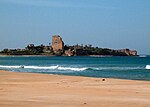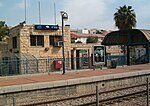Atlit detainee camp
1939 establishments in Mandatory PalestineAliyahAtlitHistory museums in IsraelImmigration detention centers and prisons ... and 6 more
Internment campsIsrael National Heritage SiteMuseums in Haifa DistrictPrisoner-of-war campsUse Oxford spelling from April 2022World War II sites in Mandatory Palestine

The Atlit detainee camp was a concentration camp established by the authorities of Mandatory Palestine in the late 1930s on what is now the Israeli coastal plain, 20 kilometres (12 mi) south of Haifa. Under British rule, it was primarily used to hold Jews and Arabs who were in administrative detention; it largely held Jewish immigrants who did not possess official entry permits. Tens of thousands of Jewish refugees were interned at the camp, which was surrounded by barbed wire and watchtowers. The camp at Atlit now has a museum that covers the history of aliyah by non-permitted Jews. It was declared a National Heritage Site by Israel in 1987.
Excerpt from the Wikipedia article Atlit detainee camp (License: CC BY-SA 3.0, Authors, Images).Atlit detainee camp
7110, Hof HaCarmel Regional Council
Geographical coordinates (GPS) Address External links Nearby Places Show on map
Geographical coordinates (GPS)
| Latitude | Longitude |
|---|---|
| N 32.712543 ° | E 34.949141 ° |
Address
מחנה עתלית
7110
3907828 Hof HaCarmel Regional Council
Haifa District, Israel
Open on Google Maps











